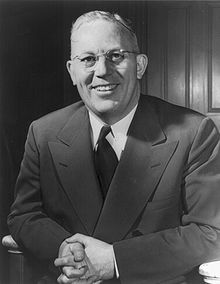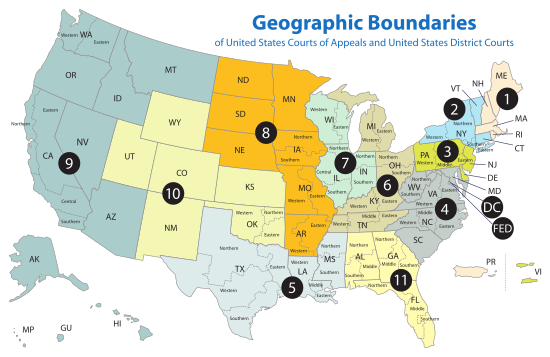Dwight D. Eisenhower Supreme Court candidates
During his two terms in office,
Earl Warren nomination

John Marshall Harlan nomination
Following the death of Justice Robert H. Jackson on October 9, 1954, Eisenhower nominated John Marshall Harlan II on November 9, 1954. Harlan had at the time been sitting on the United States Court of Appeals for the Second Circuit for only nine months.[8] On being nominated, the reticent Harlan called reporters into his chambers in New York, and stated, in full, "I am very deeply honored."[9]
The United States Senate did not initially act on his nomination, and Eisenhower had to renominate Harlan on January 10. Harlan's nomination came shortly after the Supreme Court handed down its landmark decision in
William Brennan and Charles Evans Whittaker nominations
Due to ill health, Justice
Brennan gained the attention of Eisenhower's attorney general and chief legal affairs adviser,
Before Brennan's nomination was considered by the Congress, Justice Stanley Forman Reed announced his retirement from the Court on February 25, 1957, citing old age. Reed was 73 years old,[22] but had also begun to feel that the Court's jurisprudential center had shifted too far away from him, and that he was losing his effectiveness.[23] Within a week of Reed's retirement, on March 2, 1957, Eisenhower nominated Charles Evans Whittaker to succeed Reed.[24]
Both Brennan and Whittaker were confirmed by voice vote in the United States Senate on March 19, 1957.[5][25]
Potter Stewart nomination
Names mentioned
Following is a list of individuals who were mentioned in various news accounts and books as having been considered by Eisenhower for a Supreme Court appointment:
United States Supreme Court (elevation to Chief Justice)
- Harold H. Burton (1888-1964)[27]
- Robert H. Jackson (1892-1954)[27]
United States courts of appeals
- Court of Appeals for the Second Circuit
- John Marshall Harlan II (1899-1971) — (nominated and confirmed)[5]
- Court of Appeals for the Fourth Circuit
- John J. Parker (1885-1958)[27]
- Court of Appeals for the Fifth Circuit
- Elbert Parr Tuttle (1897-1996)[27][28]
- Court of Appeals for the Sixth Circuit
- Potter Stewart (1915-1985) — (nominated and confirmed)[5]
- Court of Appeals for the Eighth Circuit
- Charles Evans Whittaker (1901-1973) — (nominated and confirmed)[5]
- Court of Appeals for the Tenth Circuit
- Orie L. Phillips (1885-1974)[27]
- Court of Appeals for the D.C. Circuit
- Warren E. Burger (1907-1995) (later nominated as Chief Justice by President Richard Nixon and confirmed)[27][28]
- John A. Danaher (1899-1990)[27]
United States district courts
- George H. Boldt (1903-1984) — Judge, United States District Court for the Western District of Washington[27]
State supreme courts
- New Jersey Supreme Court (nominated and confirmed)[5]
- New Jersey Supreme Court[27]
- Boyd Leedom (1906-1969) — Chairman of the National Labor Relations Board, former Justice, South Dakota Supreme Court[29]
Executive branch officials
- Herbert Brownell (1904-1996) — United States Attorney General[27][28]
- John Foster Dulles (1888-1959) — United States Secretary of State[1][27][28][30]
- John J. McCloy (1895-1989) — former United States High Commissioner for Germany[31]
- Kenneth Claiborne Royall (1894-1971) — Former United States Secretary of War under Truman[27]
State governors
- Thomas E. Dewey (1902–1971) — Governor of New York and former Republican presidential nominee[27][28][2]
- Earl Warren (1891–1974) — Governor of California (nominated and confirmed)[5]
See also
References
- ^ ISBN 0132223155.
- ^ ISBN 9780762784219.
- ^ Slate.com(June 14, 1999).
- ^ Personal and confidential To Milton Stover Eisenhower, October 9, 1953. In The Papers of Dwight David Eisenhower, ed. L. Galambos and D. van Ee, doc. 460. World Wide Web facsimile by The Dwight D. Eisenhower Memorial Commission of the print edition; Baltimore, MD: The Johns Hopkins University Press, 1996 Archived January 18, 2012, at the Wayback Machine. Accessed October 12, 2005.
- ^ a b c d e f g h Supreme Court Nominations, 1789-present, senate.gov.
- ^ "Senate – March 1, 1954" (PDF). Congressional Record. 100 (2). U.S. Government Printing Office: 2381. Retrieved February 18, 2022.
- ^ Michael A. Kahn, "Shattering the myth about President Eisenhower's Supreme Court appointments." Presidential Studies Quarterly 22.1 (1992): 47-56 online.
- ^ "Marshall, John Harlan". Federal Judicial Center. Archived from the original on 2008-09-20. Retrieved 2008-08-14.
- ^ Rosenbaum, David E. (September 24, 1971). "'A lawyer's judge; John Marshall Harlan". The New York Times. Retrieved 2009-04-17. (fee for article)
- ^ 347 U.S. 483 (1954)
- ^ Dorsen, 2006.
- ^ "United States Senate. Nominations". United States Senate. Retrieved 2008-10-09.
- ^ Epstein, 2005.
- ^ "Senate – March 16, 1955" (PDF). Congressional Record. 101 (3). U.S. Government Printing Office: 3036. Retrieved February 18, 2022.
- ^ Dorsen, 2002, pp. 139–143.
- ^ Oyez Project, Supreme Court media, Sherman Minton.
- ISBN 0-671-76787-9.
- ^ James Taranto, Leonard Leo (2004). Presidential Leadership. Wall Street Journal Books. Retrieved 2008-10-20.
- ^ Kessler, Glenn (February 24, 2016). "A recent Supreme Court appointment in an election year — without controversy". Washington Post. Retrieved March 22, 2016.
- ^ ISBN 0-671-76787-9.
- ISBN 0-671-76787-9.
- ^ Huston, "Justice Reed, 72, to Retire From the Supreme Court," New York Times, February 1, 1957; "Justice Reed Retires From Supreme Court," New York Times, February 26, 1957.
- ^ Fassett, New Deal Justice: The Life of Stanley Reed of Kentucky, 1994.
- ^ "Federal Judge in Missouri Named to Supreme Court," New York Times, March 3, 1957.
- ^ "Senate – March 19, 1957" (PDF). Congressional Record. 103 (3). U.S. Government Printing Office: 3946. Retrieved February 18, 2022.
- ^ "Senate – May 5, 1959" (PDF). Congressional Record. 105 (6). U.S. Government Printing Office: 7472. Retrieved February 18, 2022.
- ^ ISBN 978-0-226-94545-3.
- ^ ISBN 978-1-4165-4151-6.
- ^ "Leedom Backed for Seat on Supreme Court". Rapid City Journal. Rapid City, South Dakota. 28 February 1957. p. 1.
- ISBN 0700602674.
- ^ Brandt, Raymond P. (September 27, 1953). "A New Chief Justice: Eisenhower Must Make Historic Decision — Will President Appoint the Best Man Available or Will He Listen to Partisan Politicians". St. Louis Post-Dispatch. St. Louis, Missouri. p. 1C.
Further reading
- Kahn, Michael A. "Shattering the myth about President Eisenhower's Supreme Court appointments." Presidential Studies Quarterly 22.1 (1992): 47-56 online.
- Nichols, David A. A matter of justice: Eisenhower and the beginning of the civil rights revolution (Simon and Schuster, 2007).

